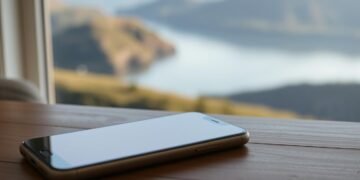In today’s hyper-connected world, we’re constantly bombarded by notifications, emails, and endless scrolling. The average person spends over 11 hours a day interacting with screens. But what if we told you there’s a way to reclaim your time and focus?
Just like intermittent fasting for food, a digital detox can help reset your relationship with technology. Dr. John Townsend’s work on boundaries and Gin Stephens’ principles of fasting provide a solid foundation for this approach. By stepping away from your devices, you can gain mental clarity, strengthen relationships, and boost productivity.
We’ll explore how to start and maintain this practice, making it a sustainable part of your lifestyle. It’s not about deprivation—it’s about building skills to thrive in a tech-driven world. Let’s dive in together and discover the benefits of intentional breaks from technology.
Key Takeaways
- Intentional tech breaks can improve mental health and focus.
- Reducing screen time strengthens personal relationships.
- Dr. John Townsend’s boundary theory supports healthy tech habits.
- Fasting principles apply to both food and devices.
- Small, consistent changes lead to long-term benefits.
What is a Weekend “Digital Fast”?
Intentional disconnection from devices is a growing trend for mental clarity. A digital fast is a voluntary break from internet-connected tools like phones, computers, and apps. Think of it as setting “property lines” for your tech use—clear boundaries that protect your mental space.
Unlike a full digital detox, which can last days or weeks, a weekend approach is more manageable. It’s like the 5:2 method in intermittent fasting: five days connected, two days off. This balance allows you to reset without feeling overwhelmed.
Cal Newport’s 30-day digital declutter is another option for those seeking a longer reset. However, a weekend digital fast offers a practical starting point. It’s not about cutting out technology permanently but creating intentional breaks to recharge.
Tools like iOS 15 Focus Mode can help you implement this practice. Unlike simple screen time reduction, a digital fast emphasizes mindfulness. For example, the minimalism community often takes breaks from Instagram to focus on real-life connections.
As William Powers notes, an “information diet” is essential for cognitive health. A digital fast isn’t abstinence—it’s a temporary pause to regain control over your time and attention. Whether you choose a full detox or a weekend break, the goal is to thrive in a tech-driven world.
Why You Should Try a Weekend “Digital Fast”
Taking a break from screens can transform your daily life in surprising ways. By stepping away from constant notifications and scrolling, you give your brain a chance to reset. This simple act can lead to significant improvements in your overall well-being.
Improved Mental Health
Reducing stress is one of the most immediate benefits of a tech break. Studies show that participants in a one-week detox reported a 27% reduction in stress levels. Dr. Anna Lembke’s research on dopamine reset highlights how stepping away from variable rewards—like social media notifications—can rebalance your mental health.
Enhanced Productivity
Without constant distractions, your ability to focus improves dramatically. A break from tech allows you to tackle tasks with greater efficiency. This shift can lead to a noticeable boost in productivity, helping you achieve more in less time.
Better Sleep Patterns
Exposure to blue light from screens can disrupt your natural sleep cycle. By disconnecting before bed, you give your body a chance to wind down. This simple change can lead to deeper, more restorative sleep.
Deepened Personal Relationships
Spending less time on devices creates more opportunities for meaningful connections. Whether it’s a conversation with a loved one or quality time with friends, stepping away from tech strengthens your relationships. This intentional focus on real-life interactions can lead to greater emotional fulfillment.
How to Start Your Weekend “Digital Fast”
Starting a tech break doesn’t have to be overwhelming—it’s about small, intentional steps. By setting clear goals and creating a structured plan, you can make this practice a seamless part of your life. Let’s explore how to begin.
Setting Realistic Goals
Begin with the SMART framework: Specific, Measurable, Achievable, Relevant, and Time-bound. For example, instead of saying, “I’ll reduce my screen time,” try, “I’ll limit my phone use to one hour daily for the next seven days.”
Consider starting small. A one-hour daily break can be more sustainable than a full-weekend detox. Replacement tactics, like doing 20 squats instead of scrolling, can help you build new habits. Ask yourself, “Can I meal-prep without taking phone photos?” This readiness quiz can gauge your preparedness.
Creating a Digital Fasting Schedule
Choose a model that fits your lifestyle. The 16:8 method involves 16 hours of fasting and 8 hours of tech use, while the 5:2 approach suggests five days of regular use and two days off. Both models offer flexibility and balance.
Track your progress using tools like Google Sheets. Note how you feel during your breaks and adjust your schedule as needed. This mindful approach ensures your tech habits align with your goals.
Remember, it’s not about perfection but progress. Small, consistent changes will help you reclaim your time and focus, leading to a more fulfilling experience.
Overcoming Challenges During Your Digital Fast
Breaking free from tech habits requires patience and strategy. While the benefits are clear, the journey isn’t always easy. We’ll explore practical ways to manage cravings and stay motivated, helping you stay on track.
Managing Digital Cravings
Tech cravings are a common hurdle. The “surf the urge” technique from addiction therapy can help. When the urge to check your phone strikes, pause and observe the feeling without acting on it. Most cravings subside within 15 minutes.
Another effective strategy is app-specific friction. For example, switching your phone to grayscale mode reduces its visual appeal. This small change can make a big difference in curbing distractions.
Source 1’s “delay don’t deny” philosophy suggests waiting before giving in to cravings. This approach helps build self-control over time. By practicing these techniques, you’ll strengthen your mind and reduce dependency on devices.
Maintaining Motivation
Staying motivated is key to long-term success. Source 2’s group accountability strategies can help. Share your goals with family or friends who can encourage and support you.
Source 3’s advice on normalizing failure is also valuable. If you slip up, don’t be too hard on yourself. Instead, focus on progress, not perfection. Celebrate small wins to keep your motivation high.
Finally, fill your time with meaningful activities. Whether it’s reading, exercising, or spending time with loved ones, these alternatives make the process enjoyable. By focusing on what truly matters, you’ll create a more balanced life.
Tools and Resources to Support Your Digital Fast
Building a healthier relationship with technology requires the right tools and strategies. Whether you’re looking to reduce distractions or create intentional breaks, there are practical solutions to help you succeed. Let’s explore some of the best resources to support your journey toward digital minimalism.
Using Apps Like Freedom
Apps like Freedom, Cold Turkey, and StayFocusd are designed to help you regain focus by blocking distractions. Freedom stands out for its cross-device syncing, allowing you to block notifications on your phone, tablet, and computer simultaneously. This feature ensures a consistent experience across all your devices.
Setting up scheduled blocks is simple. For example, you can block social media apps during specific hours to create uninterrupted work or relaxation time. However, it’s important to remember that these tools are most effective when paired with a mindset shift. Over-reliance on apps without addressing underlying habits may limit long-term success.
Creating Tech-Free Zones
Another effective strategy is establishing tech-free zones in your home. For instance, keeping phones and other devices out of the bedroom can improve sleep by reducing exposure to blue light. Similarly, making the dinner table a tech-free space encourages meaningful conversations with family.
For those seeking a more drastic change, switching to a “dumb phone” can be a game-changer. These basic phones eliminate the temptation to scroll, helping you stay present in the moment. By combining these strategies, you can create a balanced approach to technology use.
Remember, the goal isn’t to eliminate technology but to use it intentionally. With the right tools and mindset, you can reclaim your focus and enjoy a more fulfilling life.
Conclusion
Taking control of your tech habits opens doors to greater clarity and focus. Think of it as digital nutrition—just as a balanced diet fuels your body, mindful tech use nourishes your mind. Before a break, your brain might feel like a car running on empty. Afterward, it’s tuned up and ready to go.
We challenge you to a 30-day digital fasting experiment. Share your journey with #TechReset and join a community committed to reclaiming their time. Emerging trends, like AI-assisted fasting, are making it easier to build this practice into your lifestyle.
As Gin Stephens wisely said, “Delay don’t deny.” This mindset helps you pause before reaching for your phone, giving you back control. Download our free checklist to guide your weekend breaks and stay on track.
Remember, you control the scroll. By making intentional choices, you can create a healthier, more fulfilling life—one break at a time.
FAQ
What is a Weekend "Digital Fast"?
A Weekend “Digital Fast” is a practice where you intentionally disconnect from devices like phones, computers, and tablets for a set period, usually over the weekend. This helps reduce screen time and allows you to focus on offline activities.
Why should I try a Weekend "Digital Fast"?
Taking a break from technology can improve mental health, boost productivity, enhance sleep quality, and strengthen personal relationships. It’s a way to reset and recharge without constant connectivity.
How do I start a Weekend "Digital Fast"?
Begin by setting realistic goals, like limiting screen time to specific hours. Create a schedule that works for you, and gradually reduce your reliance on devices to make the transition easier.
What are some challenges I might face during a Digital Fast?
Common challenges include managing cravings to check notifications and staying motivated. To overcome these, try engaging in offline activities like reading, exercising, or spending time with family.
Are there tools to help with a Digital Fast?
Yes, apps like Freedom can block distracting websites and apps. You can also create tech-free zones in your home to encourage a device-free environment during your fast.
How does a Digital Fast improve mental health?
Reducing screen time lowers stress and anxiety caused by constant connectivity. It also allows your brain to rest, improving focus and emotional well-being.
Can a Digital Fast help with sleep?
Yes, reducing exposure to blue light from screens before bed can improve sleep quality. A Digital Fast encourages healthier bedtime habits, leading to better rest.
What activities can I do during a Digital Fast?
Engage in offline activities like reading, journaling, exercising, cooking, or spending quality time with loved ones. These activities can enrich your life without relying on technology.








